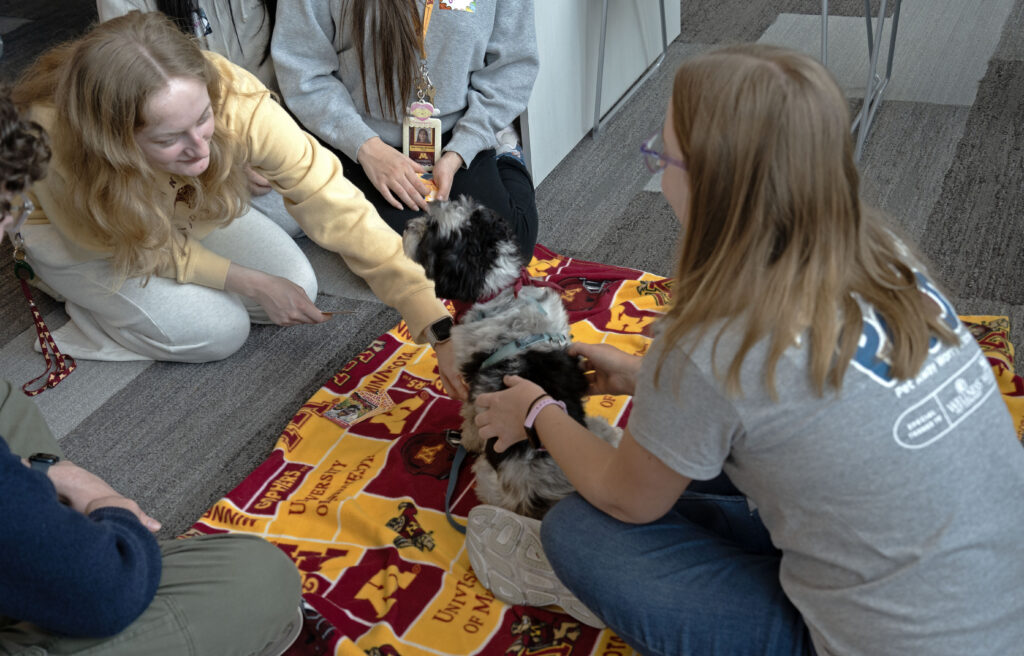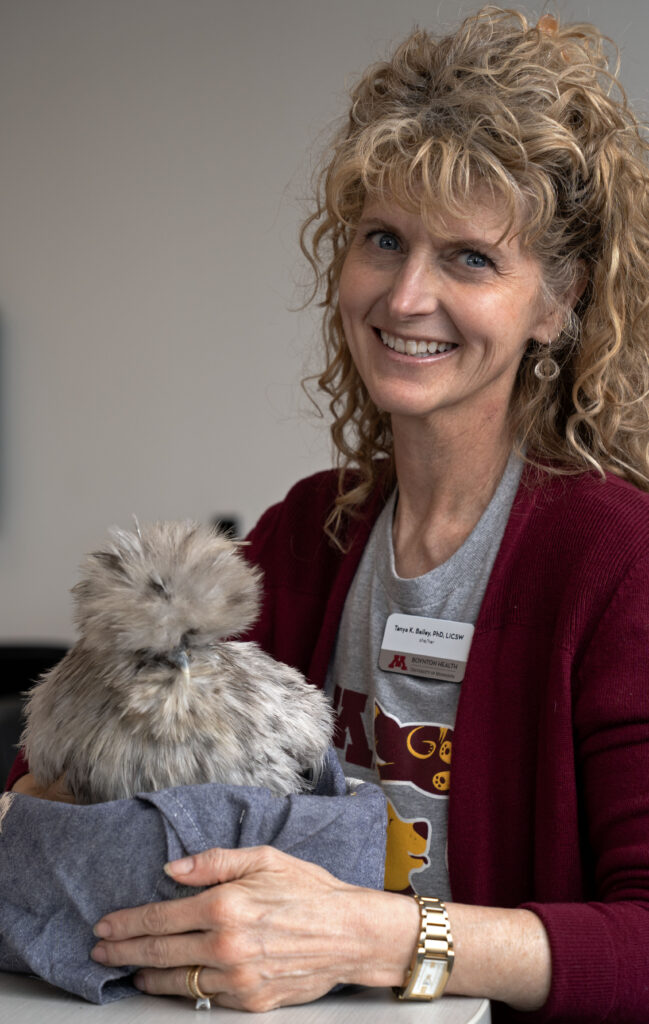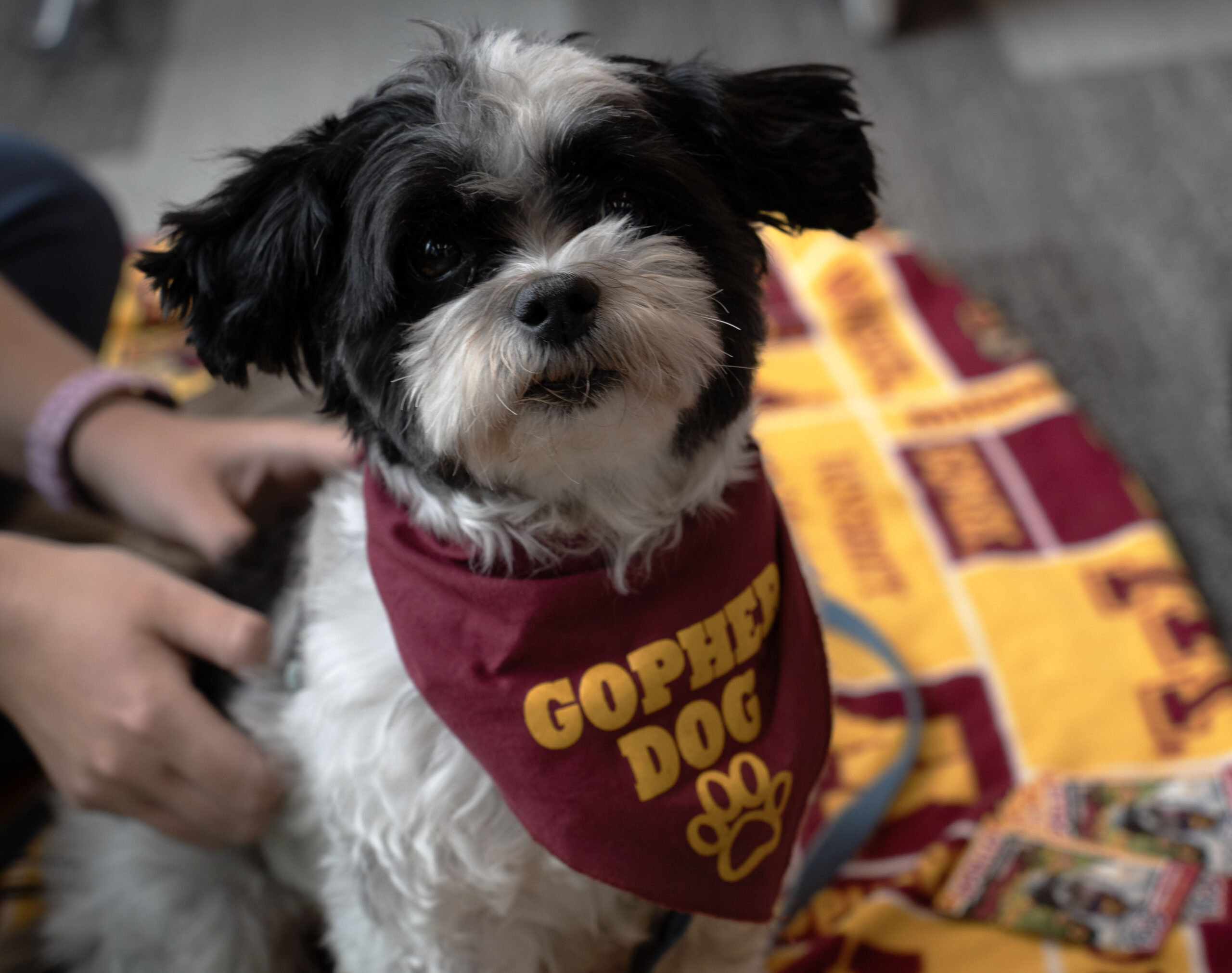By: Kinsey Gade
When Apollo comes to meet his admirers at the University of Minnesota, he styles a maroon bandana tied around his neck with the words “Gopher Dog” emblazoned in big gold letters.
The 7-year-old, 13-pound Maltese Shih Tzu mix sits patiently on a matching University of Minnesota blanket on the floor by his owner, Megan Schoenbauer. They wait for students who come by to pet and scratch his curly gray and black fur. At the university’s Pet Away Stress and Anxiety (PAWS) program, roughly five teams of dogs, bunnies, cats, guinea pigs and chickens are stationed around the Health Sciences Education Building’s seventh-floor student lounge. The absence of barking, meowing or clucking creates a calm scene for students to walk around, pet the therapy animals and start conversations with the handlers about their chaotic school schedule, beloved family pets and whatever else comes up.

Alexandra DeYoe, a third-year journalism student, said the program is a great resource for students who want to interact with different types of animals, such as chickens and rabbits and their handlers.
“I live with two dogs at home, so I am always around them, but it’s nice to take a few minutes and pay attention to them or any animal and focus on them rather than yourself,” DeYoe said.
Animal teams in the PAWS program, like Schoenbauer and Apollo, allow students to destress from their hectic university lives by interacting with therapy animals. Schoenbauer, 22, a graduate of the university nursing program, knows the emotional and physical effects of the college experience only too well.
Summer of 2020, before her first semester, Schoenbauer worked in the COVID wing of a small nursing home. Schoenbauer said she experienced a lot of death from patients she worked with, and Apollo was one of the only things that grounded her.
“When we were in peak COVID, there was someone dying every week,” Schoenbauer said. “I remember there was one day when two people died in the unit, and that was tough.”
Due to university COVID-19 restrictions, Schoenbauer’s freshman-year classes were mainly online, and much of her time was spent in solitude. She wrestled with her mental health and decided to register Apollo as an emotional support animal to come and live in her dorm for the spring semester.
Schoenbauer said Apollo helped her have a more structured and productive dorm life.

“I had a really hard time getting out of my dorm,” Schoenbauer said. “I knew if I had Apollo, he would make me go outside and make me go for walks. I would eat more because I would be feeding him and remember to feed myself.”
Although Schoenbauer had Apollo, she was also an avid attendee of the PAWS program and looked forward to interacting with other animals and people during her breaks between classes.
Schoenbauer works at Fairview Hospital now, but she hasn’t forgotten what it was like. She knew Apollo would be a great addition to the PAWS program, so she worked at obedience training until the pair was certified as a therapy dog team with Pet Partners. Schoenbauer said that PAWS has been an important routine for her and Apollo, giving them a chance to socialize and help other students.
“It’s fun to see people light up when they are petting him and chatting,” Schoenbauer said. “He gets very excited when we pull into the parking garage because then he knows why we are there.”
BENEFITS OF FURRY FRIENDS
According to UCLA Health, petting an animal triggers an automatic relaxation response, which is stimulated by mood-elevating hormones like serotonin, prolactin and oxytocin. Human-animal interactions provide comfort, minimize loneliness, increase mental stimulation and reduce stress and anxiety.
Tanya Bailey, coordinator and director of the Animal-Assisted Interactions (AAI) Program and the PAWS program researched the role animals played in college students’ mental health while earning her doctoral degree in social work. One of her dissertation’s biggest takeaways is the lack of knowledge regarding college students’ mental health.
“The needs of college students within this frame of 18 to 24 are really unique,” Bailey said. “One of the unique things is that if someone is going to develop mental illness disorders, 75% of the time it’s going to happen before they are 24.”
According to Bailey, universities and higher education institutions started implementing animal-assisted interactive programs in the early 2000s.
In a 2017 survey of more than 150 institutions, 62% had an animal-AAI program, according to Animal-assisted Stress Reduction Programs in Higher Education.
However, Bailey said that while conducting research for her dissertation, she found that many university animal programs lacked human-animal team certification.
“The animal program had to have certain parameters in place, and one of those is that the animals and handlers had to go through very specific training and evaluation,” Bailey said.
PAWS IN THE PUPPY PHASE
Bailey was initially recruited to help start an animal-based experience to help students with their stress and anxiety and advocate for mental health needs on the UMN campus.

The first iteration was Circus De-Stress, which was brought to Coffman Memorial Union to help students destress and learn about the mental health resources on campus, according to the UMN website. The event consisted of a 30-minute circus display with aerialists, high-wire walkers, jugglers and clowns. It included booths with information and resources about mental health on campus and therapy animals brought by Bailey for students to pet.
After three events, Bailey moved her animals away from the circus to a calmer environment more suitable for directly serving students’ stress, anxiety and overall mental health.
“I don’t do circuses,” Bailey said. “The animals are my colleagues. They are not my tools.”
The PAWS program, which began as a once-a-week event at Boynton Health in November 2013, requires animal and handler teams to register with national organizations specializing in therapy animals. After five years, PAWS exceeded 11,000 student visits and gradually expanded to four sessions a week across all three UMN campuses: East Bank, West Bank and Saint Paul.
During the COVID pandemic, the PAWS program was cleared for five-minute appointments with single students. In the spring semester, it was permitted to hold ten-minute meetings with students, which Bailey said was a huge benefit for their well-being.
“Ten minutes felt like quality time compared to five minutes,” Bailey said.
Bailey said students told her that the PAWS program kept them from dropping out or harming themselves because of the enforced isolation during the pandemic.
TANYA’S PEDIGREE
Bailey grew up with two beagles and a rabbit, which cultivated her appreciation and concern for animals. Her pets provided comfort and attachment during every hardship of her early life.
“I feel that connection and belonging are almost more important than food, clothing and shelter,” Bailey said.
As a licensed social worker, Bailey drove children to the Washington County Courthouse, many of whom faced child removal or placement. Torie, Bailey’s border collie, sat calmly in the back seat of her van. Petting Torie provided comfort to the children in a way Bailey could not. Now, Bailey attends almost every PAWS session, sitting at a table with one of her three Silkie chickens, which are all registered with Intermountain Therapy Animals: Hennifer, Henley and Atilla the Hen (Tilly). During the PAWS session, the chicken of the day sits obediently in a basket while Bailey talks and instructs students on how to pet.
The PAWS program now has more than 100 registered human-animal teams and is still growing. Bailey said that the longevity, legacy and integrity of PAWS are very important to her, and she plans to continue directing it until her retirement.
“I am not going anywhere anytime soon,” Bailey said. “Now that I have my Ph.D., I feel indebted to this field to help continue to provide evidence of its effectiveness, most specifically for college students. That’s my jam right there.”
